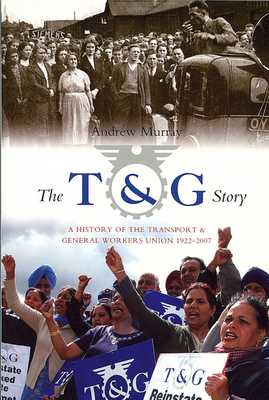The T&G Story 1922-2007
David Granville reviews The T&G Story: a history of the Transport and General Workers Union 1922-2007 by Andrew Murray, Lawrence and Wishart, ISBN 97819005007745837, £14.99 pbk

PUBLISHED IN association with the the trade union Unite, Andrew Murray's The T&G Story: a history of the Transport & General Workers Union 1922-2007 is the first full account of the union's existence from its birth as a general union in 1922 through to its recent merger with Amicus.
As one might expect of a trade union which for most of its 85 years of existence was, as Murray states in his introduction, "the biggest single influence within the TUC and the largest trade union affiliate to the Labour Party", the T&G played a key role in development of these twin pillars of the British labour movement over several decades.
One of the consequences of having to produce a history of manageable dimensions is that a number of important aspects of the union are inevitably dealt with in a fairly cursory fashion. The T&G in Ireland, Murray admits, falls into this category. He explains that the history of the Amalgamated, as the T&G is known in Ireland to distinguish it from the far larger, and separate, union of the same name formed by Connolly and Larkin, Murray acknowledges "is to some extent a story in itself, separate from many of the industrial and most of the political narratives which defined the union in Great Britain."
In doing so Murray alludes to the tangled web that is the legacy of Britain's involvement in Ireland - a legacy that has not escaped the trade union movement. While some unions organise in various parts of Britain, Northern Ireland and the Irish Republic, others have members in just Britain and the six counties. Some unions organise throughout the island of Ireland while yet others organise solely within either the twenty-six or six-county jurisdiction.
The author's assertion that "it is no exaggeration to say that it (the union) was the main bastion of a non-sectarian approach to the problems in the six counties, endeavouring to bind people together at work even as almost every other actor in play in the community was driving them apart", is largely merited, although a number of other unions could make similar claims.
Unfortunately, the union's Irish region was not always on the side of the angels - its opposition to the anti-discriminatory MacBride principles being a case in point. At a time when the Principles, launched in the mid-1980s, were winning support across broad swathes of the trade union movement in Britain and Ireland, and where the campaign in America to ensure that companies investing in the six counties had gained considerable momentum, the T&G's Irish region supported the then Tory government in opposing them.
A detailed analysis of this and other aspects of the Amalgamated's history must await, what is undoubtedly deserved, an in-depth study of their own.
Pitched at the "interested activist" and a general readership "beyond the academic market", the author does not claim that it is a comprehensive study. There is always be a place, I would go so far as to say 'a need', for accessible labour-movement history and one which acknowledges Ireland's distinct story is to be particularly welcomed.
Despite its brevity, Murray's book offers the reader much more than a simple roll call of some of the giant figures of the British trade union movement, while acknowledging the contribution such figures have made to the T&G's remarkable story.
It is a succinct and highly readable testimony to the collective struggles of millions of ordinary working people - bus drivers and conductors, dockers, car manufacturers, aviation workers and cooks - who not only fought to secure fair wages and security in the workplace but who also took up the struggle for social justice in the wider world.
Connolly Association, c/o RMT, Unity House, 39 Chalton Street, London, NW1 1JD
Copyright © 2009 David Granville

